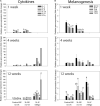Immune Activities in Choroids of Visually Impaired Smyth Chickens With Autoimmune Vitiligo
- PMID: 35547230
- PMCID: PMC9082495
- DOI: 10.3389/fmed.2022.846100
Immune Activities in Choroids of Visually Impaired Smyth Chickens With Autoimmune Vitiligo
Abstract
Vitiligo is a common dermatological disorder affecting 1-2% of the world's population. It is characterized by postnatal, autoimmune destructions of melanocytes in the skin, resulting in patches of depigmentation. Autoimmunity in vitiligo may also affect melanocytes in non-integumental tissues, including the eyes where choroidal melanocytes are the target of the autoimmune response. The Smyth line (SL) of chicken is the only animal model that spontaneously and predictably develops all clinical and biological manifestations of autoimmune vitiligo. In SL vitiligo (SLV), destruction of epidermal melanocytes in growing feathers (GFs) involves a melanocyte-specific, Th1-mediated cellular immune response. Smyth chickens may also exhibit uveitis and vision impairment. Previous studies established a strong association between SLV and vision impairment, including similar pathology in affected eyes and GFs. To determine the presence, types, and activities of choroid infiltrating mononuclear cells, we collected eyes before, near onset, and during active SLV from sighted, partially blind, and blind SL chickens. All SL chickens with vision impairment had SLV. Immunohistochemistry and quantitative reverse transcriptase-PCR analyses revealed mononuclear cell and cytokine expression profiles in the autoimmune destruction of melanocytes in choroids that are identical to those described in GF, demonstrating the systemic nature of autoimmunity against melanocytes in SLV. In addition, we observed aberrant melanogenesis in SL eyes. The immunopathogenesis in SL vision impairment resembles human vitiligo-associated ocular diseases, especially Vogt-Koyanagi-Harada syndrome and sympathetic ophthalmia. Hence, the Smyth chicken autoimmune vitiligo model provides the opportunity to expand our understanding of spontaneous autoimmune pigmentation disorders and to develop effective treatment strategies.
Keywords: Smyth chicken vitiligo model; autoimmune vitiligo; choroid melanocytes; uveitis; vitiligo-associated diseases.
Copyright © 2022 Sorrick, Huett, Byrne and Erf.
Conflict of interest statement
The authors declare that the research was conducted in the absence of any commercial or financial relationships that could be construed as a potential conflict of interest.
Figures


Similar articles
-
Apoptosis in feathers of Smyth line chickens with autoimmune vitiligo.J Autoimmun. 2004 Feb;22(1):21-30. doi: 10.1016/j.jaut.2003.09.006. J Autoimmun. 2004. PMID: 14709410
-
T cells in regenerating feathers of Smyth line chickens with vitiligo.Clin Immunol Immunopathol. 1995 Aug;76(2):120-6. doi: 10.1006/clin.1995.1105. Clin Immunol Immunopathol. 1995. PMID: 7614730
-
Profiles of pulp infiltrating lymphocytes at various times throughout feather regeneration in Smyth line chickens with vitiligo.Autoimmunity. 1997;25(4):193-201. doi: 10.3109/08916939708994728. Autoimmunity. 1997. PMID: 9344327
-
Autoimmune diseases affecting skin melanocytes in dogs, cats and horses: vitiligo and the uveodermatological syndrome: a comprehensive review.BMC Vet Res. 2019 Jul 19;15(1):251. doi: 10.1186/s12917-019-2003-9. BMC Vet Res. 2019. PMID: 31324191 Free PMC article. Review.
-
The enigma and challenges of vitiligo pathophysiology and treatment.Pigment Cell Melanoma Res. 2020 Nov;33(6):778-787. doi: 10.1111/pcmr.12878. Epub 2020 Apr 12. Pigment Cell Melanoma Res. 2020. PMID: 32198977 Review.
Cited by
-
Establishment of a promising vitiligo mouse model for pathogenesis and treatment studies.Diagn Pathol. 2024 Jul 3;19(1):92. doi: 10.1186/s13000-024-01520-2. Diagn Pathol. 2024. PMID: 38961434 Free PMC article.
References
-
- Smyth JR, Jr, Boissy RE, Fite KV. The DAM chicken: a model for spontaneous postnatal cutaneous and ocular amelanosis. J Hered. (1981) 72:150–6. - PubMed
LinkOut - more resources
Full Text Sources

